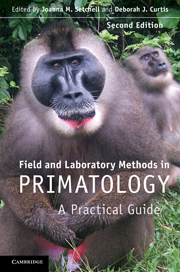Book contents
- Frontmatter
- Contents
- List of contributors
- Foreword by Robert D. Martin
- Introduction
- 1 An ethnoprimatological approach to interactions between human and non-human primates
- 2 Habituating primates: processes, techniques, variables and ethics
- 3 Habitat description and phenology
- 4 Geographical information systems and remote sensing
- 5 Monitoring local weather and climate
- 6 Survey and census methods: population distribution and density
- 7 Trapping primates
- 8 Handling, anaesthesia, health evaluation and biological sampling
- 9 Morphology, morphometrics and taxonomy
- 10 Marking and radio-tracking primates
- 11 Field experiments with non-human primates: a tutorial
- 12 Feeding ecology, frugivory and seed dispersal
- 13 Dietary analysis I: food physics
- 14 Dietary analysis II: food chemistry
- 15 Collecting arthropods and arthropod remains for primate studies
- 16 Recording primate vocalizations
- 17 Photography and video for field researchers
- 18 Chronobiological aspects of primate research
- 19 Thermoregulation and energetics
- 20 Field endocrinology: monitoring hormonal changes in free-ranging primates
- 21 Collection, storage and analysis of non-invasive genetic material in primate biology
- 22 Tips from the bush: an A–Z of suggestions for successful fieldwork
- Index
- References
14 - Dietary analysis II: food chemistry
Published online by Cambridge University Press: 05 June 2012
- Frontmatter
- Contents
- List of contributors
- Foreword by Robert D. Martin
- Introduction
- 1 An ethnoprimatological approach to interactions between human and non-human primates
- 2 Habituating primates: processes, techniques, variables and ethics
- 3 Habitat description and phenology
- 4 Geographical information systems and remote sensing
- 5 Monitoring local weather and climate
- 6 Survey and census methods: population distribution and density
- 7 Trapping primates
- 8 Handling, anaesthesia, health evaluation and biological sampling
- 9 Morphology, morphometrics and taxonomy
- 10 Marking and radio-tracking primates
- 11 Field experiments with non-human primates: a tutorial
- 12 Feeding ecology, frugivory and seed dispersal
- 13 Dietary analysis I: food physics
- 14 Dietary analysis II: food chemistry
- 15 Collecting arthropods and arthropod remains for primate studies
- 16 Recording primate vocalizations
- 17 Photography and video for field researchers
- 18 Chronobiological aspects of primate research
- 19 Thermoregulation and energetics
- 20 Field endocrinology: monitoring hormonal changes in free-ranging primates
- 21 Collection, storage and analysis of non-invasive genetic material in primate biology
- 22 Tips from the bush: an A–Z of suggestions for successful fieldwork
- Index
- References
Summary
INTRODUCTION
The preceding chapter introduced dietary analysis and discussed physical aspects of potential foods as they might influence feeding behaviour. Here, we deal with chemical aspects of potential foods. From the outset though, we should point out that attempts to explain the influence of chemical factors on primate nutrition, and the dietary factors that promote or deter the uptake of nutrients, are limited by our understanding of how the primate gut operates. It is unclear what the optimal dietary requirements are even for humans. Gut research is developing on both theoretical (see, for example, Jumars, 2000) and practical levels (Dominy et al., 2004), but it is important to point out that the effective rate of uptake is not simply a question of enzymatic action. The quantity of plant fibre that a primate ingests has a major influence on the rate of passage of food through the gut and thus digestibility (Lambert, 2002). Variable gut populations of microorganisms and parasites also play a large positive or negative role, particularly in relation to specializations in the stomach or large intestine. The situation is even less clear when it comes to chemical compounds that act as feeding deterrents, toxins or anti-nutritional factors. These have largely been bred or processed out of the agricultural products on which humans feed, so they have received relatively little attention in food science.
- Type
- Chapter
- Information
- Field and Laboratory Methods in PrimatologyA Practical Guide, pp. 255 - 270Publisher: Cambridge University PressPrint publication year: 2011
References
- 2
- Cited by

